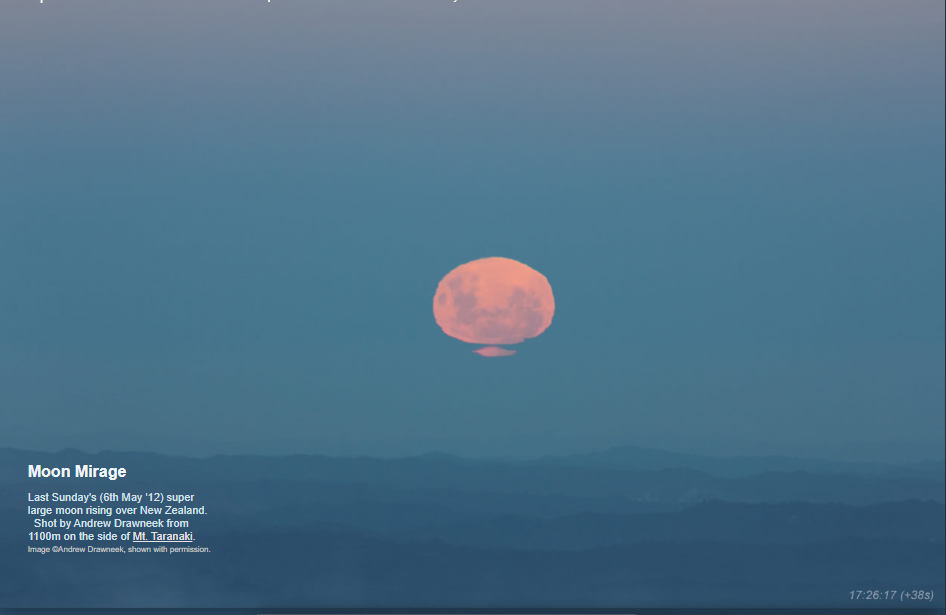OPOD - Super-Moon Mirage
OPOD - Super-Moon Mirage: A Spectacular Optical Phenomenon
The phenomenon of a super-moon mirage has captivated sky gazers for centuries. On the 6th of May, 2012, Andrew Drawneek captured an extraordinary image of the super large moon rising over New Zealand from the side of Mt. Taranaki. The image showcases the moon's transformation as it climbed over the landscape, with ripples and indents sliding from top to bottom in a matter of seconds. This breathtaking event is a result of multiple temperature inversion layers and the interaction of light with the atmosphere.
Temperature inversion layers occur when horizontal air layers become unusually warmer than those immediately below them. These layers are typically stable and quiescent, creating an environment where light can exhibit peculiar behaviors. The upper boundary of the main layer is faintly visible on the right side of the image, slightly below the large pinch. As the moon continues to ascend, its rays no longer pass through this main layer boundary, leading to a change in its appearance.
Air, although insubstantial, plays a crucial role in the formation of mirages. When the rays of the moon or sun traverse the atmosphere horizontally, they encounter density gradients between layers with slightly different densities. It is these density gradients that cause refraction, altering the path of light and resulting in the distortion of celestial objects. However, due to the need for grazing incidence, these distortions and mirages are typically limited to a few degrees above the horizon.
The distortions observed during a super-moon mirage are predominantly vertical, appearing as upward or downward shifts in the shape of the moon. Reports of "double suns" or moons with secondary images to the side are often caused by viewing or photographing through windows, where reflections and refractions within the glass create optical illusions. To witness the true wonder of a super-moon mirage, direct observation of the celestial body is necessary.
The phenomenon of a super-moon mirage is not exclusive to New Zealand; it can occur in various parts of the world under specific atmospheric conditions. The interaction between light and the atmosphere gives rise to an array of optical phenomena, each with its own unique characteristics. Exploring these phenomena allows us to deepen our understanding of the complexities of the natural world and appreciate the beauty that lies beyond our everyday perception.
In conclusion, the super-moon mirage captured by Andrew Drawneek serves as a reminder of the awe-inspiring wonders that can be found in our skies. Through the interplay of temperature inversion layers and the refraction of light, the moon's appearance undergoes a dramatic transformation as it rises above the horizon. These fleeting moments provide a glimpse into the intricacies of atmospheric optics and remind us of the boundless beauty that surrounds us.

Moon Mirage
Last Sunday's (6th May '12) super large moon rising over New Zealand. Shot by Andrew Drawneek from 1100m on the side of Mt. Taranaki. Image ©Andrew Drawneek, shown with permission.


The moon changed shape over a few tens of seconds. As it climbed over the landscape, ripples and indents slid from top to bottom .
A piece has broken off in the top image made 38s after the pinched moon at right.
The rising moon was viewed through multiple temperature inversion layers � horizontal air layers unusually warmer than those immediately below. The layers are usually stable and quiescent rather than turbulent. The upper boundary of the main layer is very faintly visible at right (slightly below the large pinch). At lower right the moon has climbed sufficiently that its rays are no longer passing through the main layer boundary.
Air is insubstantial. The moon�s or sun�s rays must traverse it almost horizontally to be significantly refracted between layers at slightly different density (it is density gradients rather than temperature differences themselves that refract).
The need for grazing incidence restricts sun/moon distortions and mirages to within a few degrees above the horizon.
Similarly, the distortions are upwards or downwards. The frequently reported "double suns" or moons with a secondary image to the side are invariably caused by viewing or shooting through windows.

Note: this article has been automatically converted from the old site and may not appear as intended. You can find the original article here.
Reference Atmospheric Optics
If you use any of the definitions, information, or data presented on Atmospheric Optics, please copy the link or reference below to properly credit us as the reference source. Thank you!
-
<a href="https://atoptics.co.uk/blog/opod-super-moon-mirage/">OPOD - Super-Moon Mirage</a>
-
"OPOD - Super-Moon Mirage". Atmospheric Optics. Accessed on April 25, 2024. https://atoptics.co.uk/blog/opod-super-moon-mirage/.
-
"OPOD - Super-Moon Mirage". Atmospheric Optics, https://atoptics.co.uk/blog/opod-super-moon-mirage/. Accessed 25 April, 2024
-
OPOD - Super-Moon Mirage. Atmospheric Optics. Retrieved from https://atoptics.co.uk/blog/opod-super-moon-mirage/.